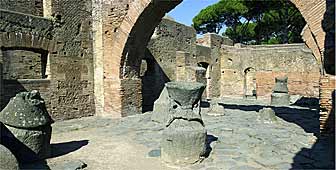
Geneva hosts first exhibition on gateway to Rome

Geneva's Musée Rath is hosting the world's first exhibition devoted to the port of Ostia, once the world's finest port and the gateway to ancient Rome.
Ostia, which sits at the mouth of the Tiber (it’s name means mouth of a river), was the lifeline for the million-strong population of Rome. Through its busy harbours came grain from North Africa, marble for buildings, exotic animals for the Colosseum, and new ideas and religions.
“Ostia was the gateway to the most important city in the ancient world,” says Jean-Paul Descoeudres, professor of classical archaeology at the University of Geneva, who had the idea for the exhibition.
After Pompeii, it is one of the best-preserved cities of the Roman Empire. Unlike Rome, it has not become a modern city. Instead it was abandoned as Rome’s importance declined and the harbour became silted up.
“Ostia is very well preserved. It gives us a very good idea of what second century Rome must have looked like,” Descoeudres told swissinfo.
Today, the ruins of Ostia cover around 55 hectares, of which 34 have been excavated. Teams from Geneva University have been involved in several of the digs.
The exhibition at the Musée Rath displays two huge models of Ostia, as well as hundreds of artefacts, many of which are being seen outside Italy for the first time. They provide a fascinating insight into the lives of the 50,000 merchants, craftsmen, sailors and others who inhabited this famous port.
To accommodate them, Ostia was built up vertically with large multi-storey blocks: “They provided the blueprint for the five- and six-storey apartment blocks of modern Rome. So it is of great interest to modern town-planners,” Descoeudres explains.
“Ostia was built at high speed. Within a couple of generations it grew from being a small port to a major international harbour city,” he adds.
There were in fact two ports in Ostia, which experts believe was far from being an ideal location for a harbour. It was first a river port, the goods being hauled on barges along the Tiber by teams of cattle.
But as Rome grew, Ostia could not accommodate the hundreds of ships that were needed to satisfy the demands of the capital. The emperors Claudius and Trajan were responsible for creating the bustling seaport, boasting a lighthouse to rival that of Alexandria and capable of handling some 350 boats at a time.
Descoeudres was involved in the much-travelled Pompeii exhibition but decided that it was Ostia’s turn. He says that this was partly because “Pompeii had done the rounds” but also because it was time to rehabilitate the port city.
“Ostia was largely excavated during the fascist period in the 1930s and so many archaeologists were loath to talk about Ostia because it had these fascist connotations,” he says. “It’s high time we got over that”.
Ostia was not only the commercial gateway to Rome, but also a kind of spiritual gateway. Like all harbour cities it was cosmopolitan and open to new ideas. The “eastern religions” found fertile ground.
“Christianity entered Rome from Ostia. There were Christians in Ostia by the Second Century, as well as the first synagogue.
“It’s fitting that this first exhibition about Ostia should be in Geneva, since one of the biggest early Christian complexes is being excavated under St Pierre Cathedral,” Descoeudres told swissinfo.
by Roy Probert

In compliance with the JTI standards
More: SWI swissinfo.ch certified by the Journalism Trust Initiative




























You can find an overview of ongoing debates with our journalists here . Please join us!
If you want to start a conversation about a topic raised in this article or want to report factual errors, email us at english@swissinfo.ch.